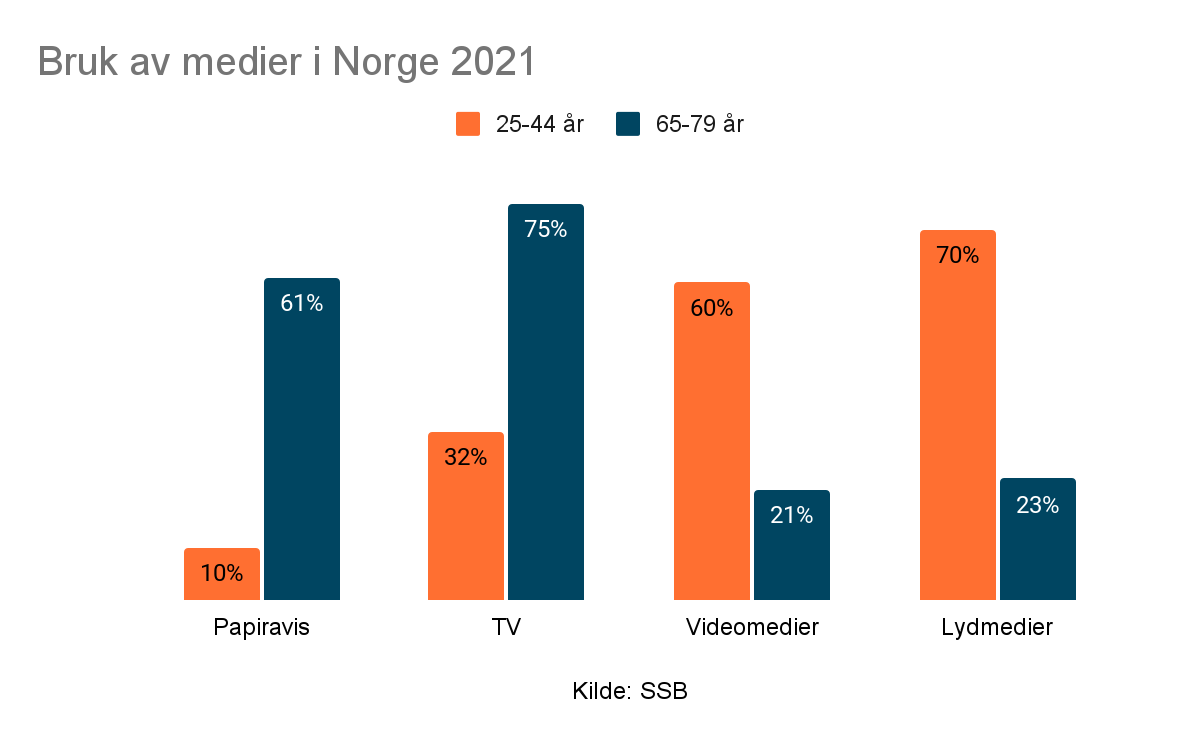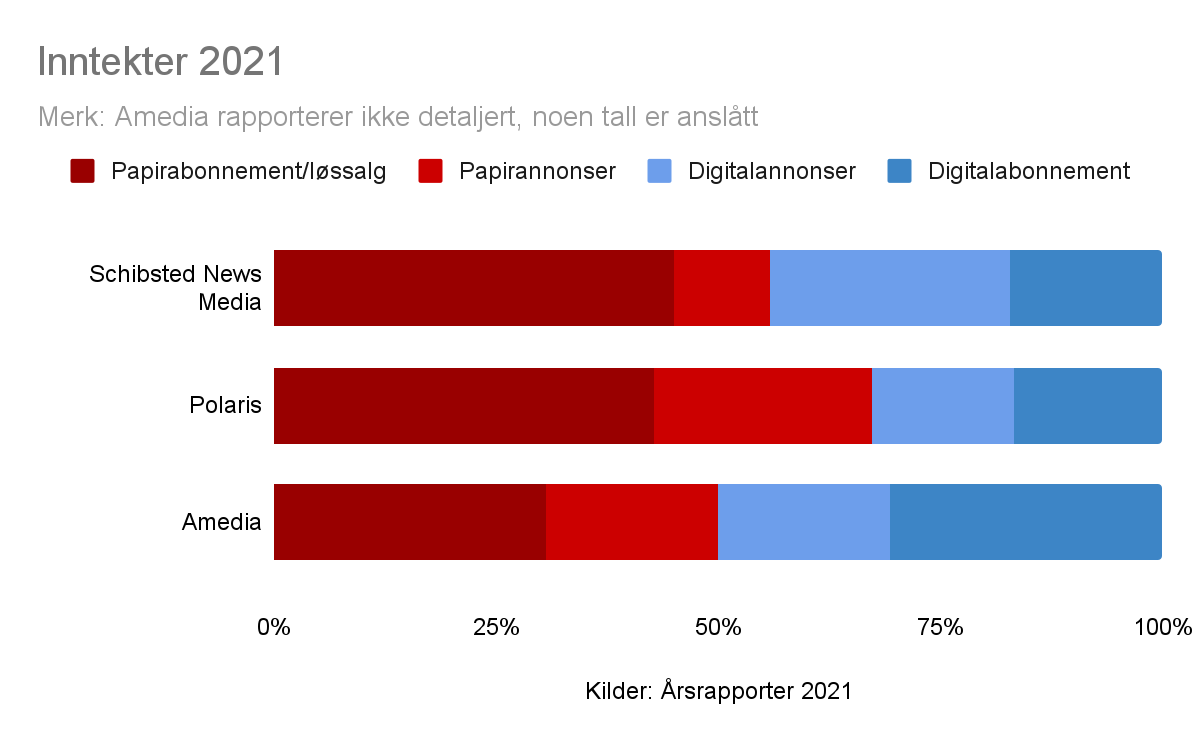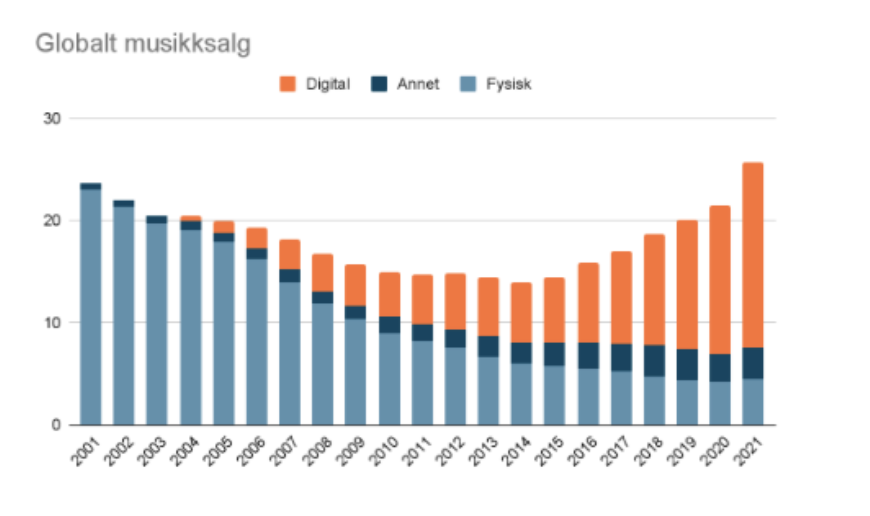Winter is coming. Interest rates are increasing, energy prices are going to the roof, prices for goods and services are escalating, and shops have filled up their inventories. The shopping bonanza we experienced during the pandemic has drastically stopped.
Re-post from Skavl.no, article by Sturle Rasmussen.
Despite the downturn, established companies must avoid hitting the breaks while being in the middle of a transition from old business models to new ones. Business models and sales channels based on the internet's existence involve less risk, scale better and are more efficient than the old models.
The media are often called the canaries in the coal mine in the transition to a digitised society. Sound, images, text and video: everything that newspapers, publishers, TV and the music industry create can be distributed and sold over the internet. The media were the early movers, providing the next movers valuable insights and learnings; across books, newspapers, TV, and music.
Diagram: Media consumption in Norway, 2021 (SSB):
Printed newspaper (Papiravis)
TV, video platforms (Videomedier)
Audio platforms (Lydmedier):
Orange: Age group 25-44
Blue: Age group 65-79 
A statistic showing an average may obscure the fact, seen clearer by using cohorts or groups for analysing a market or a business. Media consumption compares one generation, adults when the Internet came and still read printed newspapers and watch TV, to another age where everything takes place on mobile phones.
Books
Printed book sales still show steady numbers, while digital audiobooks drive growth in overall book sales. Audiobooks now account for 30 per cent of total sales, albeit with weak profitability.
On the other hand, E-books in Norway are an example of a lost opportunity. The publishers never agreed on a user-friendly standard in Norway and hesitated to invest. The result: only a meagre of four per cent of book sales now take place as e-books, compared to 18 per cent in the US. Many of us read books in English on Kindle at the expense of Norwegian-language books.
The same thing seemed to happen in the textbook market. But now, publishing houses are investing in this market. In primary schools, digital teaching aids from publishers have gone from nothing a few years ago to a quarter of the turnover so far in 2022.
Newspapers
The newspapers lost a significant part of their income twenty years ago when they digitalised ads. Then followed many years of wandering in the desert as newspaper readers dwindled, ad prices fell, and display ads proved a dead end.
lLeft-hand side diagram: Norwegian newspapers, 2021 (SSB):
In blue: Total income(Omsetning)
Red line: Results/margin (Driftsmargin)
Right-hand side: Income in Norwegian newspapers, 2021 (SSB).
Blue bar: Advertisement (Reklame)
Red bar: Subscriptions (Abonnement) 
In the last five years, newspapers have been back in the game through digital subscriptions and shifting the focus from advertisers to readers. But now, growth seems to be levelling off before reaching a critical mass digitally. Digital subscription, a business model with margins at the same level as software licenses (80%+-), only accounts for around a fifth of revenues.
Diagram: Income 2021 from 3 major media houses in Norway:
Dark red bar: Printed newspaper subscriptions and traditional sales (Papirabonnement/løssalg)
Red bar: Advertisements in printed newspapers (Papirannonser)
Light blue bar: Advertisements in digital (Digialtannonser)
Dark blue bar: Digital subscriptions (Digitalabonnemenet) 
Print still accounts for the majority of the income. The newspaper groups still own both the distribution and publishing facilities. Increases in commodity and energy prices hit them hard.
Television
For TV, the decrease in advertising revenue came later than for newspapers. TV advertising continued to grow until five years ago. Revenue from digital is significant, but expensive rights purchases limit profitability.
Left-hand side diagram - Income and results in Norwegian commercial TV channels:
Blue bar: Income (Omsetning)
Red line: Results/margin (Driftsmargin)
Right-hand side diagram - Income in Norwegian TV channels:
Blue bar: income from advertisement (Reklame)
Red bar: income from users (Brukerinntekter) 
Music
On the other hand, music is sold and distributed more or less equally across generations. After the streaming services went live, it took a few years before the industry moved to a new business and distribution logic: Music sold and distributed as a subscription. The artists make a living from related activities such as concerts, product sales, sponsorships, and rights. Turnover is growing again.
Diagram: Global music sales:
Orange bar: Digital
Dark blue bar: Other (Annet)
Grey bar: Physical (Fysisk) 
Platforms
The media companies are striving to take ownership of the platforms where the readers, viewers and listeners consume the content. In Norway, NRK and Schibsted are trying to create digital platforms for audio and video and limit distribution through Spotify, YouTube and Apple. Whoever owns the platform where users and providers meet can, in theory, dictate the terms, and the media companies would prefer to own their distribution.
But it is not that simple. Spotify does not have a monopoly in music and is struggling with profitability. Competitors like Apple and Amazon don't need to make money. As of now, it is the three major record companies that are winning on the current model. Netflix and TV channels have the same problem: TV rights are temporary and expensive, and the fans follow the teams and the sport, not a TV channel.
Independent content creators create their success through platforms separate from traditional media companies.
A platform requires a critical mass. Here, Norway and the Nordic countries quickly become insignificant and too small, a known fact for audiobook services and publishers.
The local and niche newspapers with a strong position with a good starting point for capturing value digitally: They have unique content and loyal readers who come directly to the online newspapers and can charge a high price, at least in Norway. And: they both create and own the content.
As of now, the winners among the media are those who create and own unique content, regardless of platform.
The train is leaving
Established companies face the choice between the unclear and complex. Either continue developing digital products with no low-hanging fruits left to pick, or close the hatches and give the savings programs all the attention. Or figure out how to combine the two.
Outside the media market, where the goods consist of atoms, not just bits & bytes, changes are also significant. Online shopping, which increased drastically during the pandemic, has fallen again, but the underlying development continues. Younger people have different shopping patterns, and the rest of us follow them. Digital services provide far better selection and freedom of choice.
In other industries, the changes are more subtle. Airbnb is changing the business case for buying houses and cabins. Car sharing, car subscriptions, and modern car rentals are gradually replacing car ownership in the big cities. The list continues.
It is possible to have several thoughts simultaneously: The car industry, newspapers, retail, and television can use technology while developing their income streams. Suppose you manage to do it smartly. Combine that with generating new business models and avoiding stagnation.
The pandemic showed that crises reinforce and accelerate trends that already exist. If you've got your hands on a new model that works, it's essential to make the right move, even if there's a downturn. If not, it is now urgent to find a new model that works.





